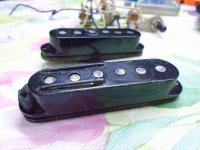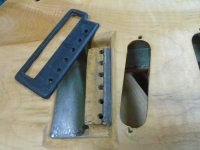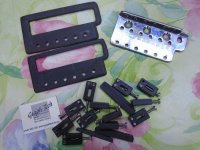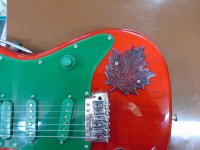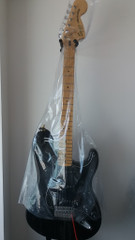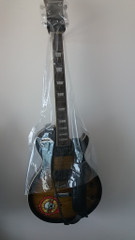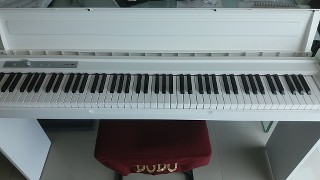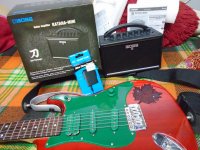alcaponedudu! It feels so nice to see you typing Hi John. It's not too late to start using your real name.
I've had a few new beginnings here. That means I've redefined myself as a new member, doing that now.
I've never heard of anyone covering their instruments because of sea air, and I'm thinking ocean air.
I have to be more specific, if I'm right, because I'm in between two Great Lakes, Ontario and Erie.
Fender had an "Antigua" colour, but yours looks darker. That's really nice.
The body shape of your Les Paul looks nicer than traditional Gibsons,
and I like the black pickups with the black sunburst, something I never saw before.
The first thing I noticed in the piano photo is "DUDU" on the seat.
That reminds me of when my mother would knit sweaters or toques with my name on them.
I haven't been tripping around music stores for a long time, but I have never seen an all-white electric piano like yours.
That's ready to make videos with, a nice contrast for you and any kind of clothes you could wear.
I like playing in low level lighting, or in the dark, and always liked the white and black keys of a piano that way.
I have always used a piece of suede to clean my strings at the end of the night,
and that really helps my fingers, keeping them feeling smooth.
I had a band practice one afternoon this week, and went downtown after.
Some girls were surprised when I said I wasn't hot about playing outside,
so I showed them my dark fingertips, saying that's the dirt the guitar attracts.
You've got me wondering what kind of strings you use. I recommend Ernie Ball.
They moved from a city in California to a desert factory, and have air-tight packages for their strings.
When guitar players were buying banjo strings to get thin strings, stepping down Fender and Gibson gauges,
Ernie Ball was the first to have thin strings, down to 008, maybe .007, and what they called balanced gauges.
They've only gotten better and the price doesn't seem to go up.
For your Strat I'd use .010 for the high E string.
Here's a photo of my cherry Strat with a new and final cover for the right-handed cord input hole.
When I made the leaf with the green plastic it looked like another version of the pick-guard.
When I shaped it and added detail, and then buffed it up with an electric tool,
it looked like jade, and the thinner outer edges showed the transparency of this illuminated sign plastic,
looking like a lighter green, adding to the jade effect.
When I used the nail polish I bought to cover the bare wood around the carving of the new cord input,
this is what it became, looking like a sugar maple leaf. Maple syrup is one of my favorite things to eat.
I'd explain more about sugar maple leaves, but that's in the following cut and paste.
I had to mess with some minds on Kijiji, so I posted this ad... uh... about musicians for a new band.
And I used this photo of the cherry Strat with the sugar maple leaf.
new/old, hot/cold, soft/bold band seeks to expand its' sound.
The Pane People, as seen on Windows, could use a wider sound.
"We used to live in a world of windowpanes,
and all we could be was inside,
until our music looked through all our panes,
now we travel both far and wide.
The Pane People are out there, so you don't have to hide."
Did you know that beavers pack part of their den with sugar maple leaves?
After they have fermented by the end of winter, the beavers start to eat them.
The Pane People see through that, just like we see through you.
yeah... I'm starting to see through you Eduardo, with your immaculate presentation.
You must have some royal Brazilian native blood in you.
Here's some news from the world of John Watt.
Graph Tech invented a new material for making nuts and bridge pieces for guitars.
It releases molecules so your strings slide easier when you're using a tremolo unit.
When I read about this invention and new company in a guitar magazine,
they didn't even have distributors in Ontario, just British Columbia.
I wrote a letter, mailed them a money order, and used their product ever since.
I sent an email asking about buying a piece so I could make a part out of it,
typing about my semi-solid-body guitar, and suggesting other uses.
I said I've been asking about this, making them for my guitar, when everyone says I'm the only one.
That's making frets on single coil pickup covers.
The one fret on my middle pickup is a fourth octave E, a nice additional note to have.
I got the typical computer reply, and then I got the personal reply from support.
And then I got another email with a link saying an account has been set up for me,
so I could visit their domain and log in to their forums so I could comment.
And then I received another email from Doug Dunwoodie, talking about my use of his material,
asking me for my mailing address and phone number.
I got another reply from support.
I got another email from Doug Dunwoodie, again asking for my mailing address and phone number,
saying he only has two pieces the size I could use, that were his.
This made me look at the domain again, and I was very surprised.
If you see the video about their new invention, tuners they call "Ratios",
that's Doug Dunwoodie, the inventor, founder and owner of Graph Tech.
They don't even sell the products with the material I bought,
having newer versions called TusQ, with the qualities of ivory, NuBone and Fossilite.
When I finished my semi-solid-bodies, they did everything new that was electrical with more acoustic harmonics,
but the guitar itself sounded tinny as an acoustic, not like a banjo, but getting there.
I didn't want to change my Graph Tech bridge pieces and nut to brass and ivory,
to get as much of a warmer sound, because that was just changing accessories.
I thought about my entire build, and came up with a new part.
I saw the pivot point where the tremolo plate pushed against the body as a problem.
That's a pivot point, where the angle of the plate acts like a hinge, nothing glued or screwed.
I saw the vibrations and the tensions of the strings and springs as getting lost,
not being translated or transmitted from the chromed metal of the plate to the wood of the body.
I decided to make a sub-plate underneath the tremolo plate out of softer material, to change that.
At first I used aluminum, thinking it was a softer metal, but it didn't do much.
I eventually used a vinyl plastic and the entire tone of the guitar changed, really nice.
The semi-solid-body has more of an acoustic quality to begin with,
so this sub-plate makes it sound more tonal compared to any solid body.
I'm going to add the photos I sent Graph Tech.
When I saw the photo of the pickups on the computer I saw how grimy they got.
That's from sticky clear-coat fingers trying them to see how they look before everything dries.
There could be some maple syrup and popcorn butter stickiness on them too.
That's over eight years of not being in a finished guitar I was playing.
It's exciting for me to be getting close.
I'm up at six this morning, going to put some clear-coat on the top and center section of my second semi-solid-body,
so when I glue the top the middle any glue that squeezes out won't soak into visible wood.
I'll also be washing my hands to dry them out so I won't leave any fingerprint smudges.
I could easily say you're lucky to be right-handed,
but when you're born in such a way that you have to adapt the world to yourself,
especially at my senior age, it makes life more interesting, whether you want it or not.
I bought a Thorold Music guitar strap,
so now I've got no excuse about standing up playing guitar to not make a video... sigh....
